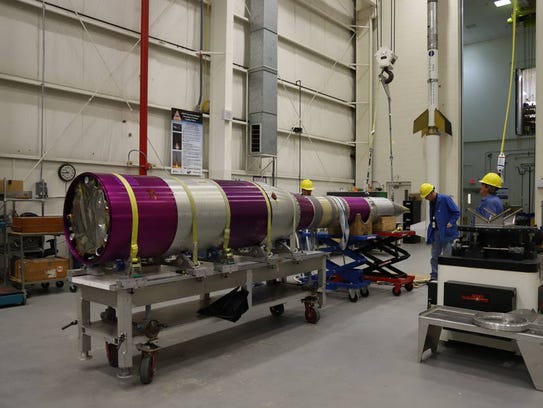Parachute test for future Mars mission to launch from Wallops

A parachute developed for use on future Mars missions will be tested during an upcoming rocket launch from NASA Wallops Flight Facility.
The launch is scheduled for Tuesday, March 27. The launch window is 6:45 to 10:15 a.m.
The parachute test will be aboard a 58-foot Terrier-Black Brant IX suborbital sounding rocket, according to a press release from NASA.
The rocket will carry the Advanced Supersonic Parachute Inflation Research Experiment, or ASPIRE.
The payload — a bullet-nosed, cylindrical structure carrying the test parachute, the parachute's deployment mechanism and high-definition instrumentation, including cameras, to record data — is expected to reach an altitude of 32 miles about two minutes into the flight.
It then will splash down in the Atlantic Ocean 40 miles from Wallops Island. NASA aims to recover it and return it to Wallops for data retrieval.
The parachute being tested is designed to slow down the spacecraft for the Mars rover mission as it enters the Martian atmosphere at more than 12,000 miles per hour.
A previous test of the ASPIRE experiment was launched successfully in October from Wallops.
"Everything went according to plan or better than planned. We not only proved that we could get our payload to the correct altitude and velocity conditions to best mimic a parachute deployment in the Martian atmosphere, but as an added bonus, we got to see our parachute in action as well," Ian Clark, the test's technical lead from NASA's Jet Propulsion Laboratory in Pasadena, California, said after the Oct. 4, 2017 test, according to a NASA press release.

The Mars 2020 rover mission will seek signs of past habitable conditions on the planet as well as signs of past life, according to a NASA mission overview.
The rover also is slated to collect samples of rocks and soils on Mars, which could be returned to Earth for study in a future mission.
The mission also is to demonstrate technologies to address some of the challenges of future human expeditions to Mars — including testing a method to produce oxygen from the planet's thin atmosphere, which is made up of 96 percent carbon dioxide.
The Mars mission is targeted to launch from Cape Canaveral in Florida in July 2020.
Live coverage of the parachute test launch at Wallops is scheduled to begin at 6:15 a.m. on March 27 on the Wallops Ustream site.
Launch updates will be available on the Wallops Facebook and Twitter sites.
Smartphone users can download the “What’s Up at Wallops” app, which contains information on the launch, as well as a compass showing the precise direction for launch viewing.
The NASA Visitor Center at Wallops will open at 6 a.m. on launch day for viewing. The launch is expected to be visible only from the Wallops area.
Backup launch dates are March 28 to April 10.
ASPIRE is managed by NASA's Jet Propulsion Laboratory in Pasadena, California, with support from NASA's Langley Research Center in Hampton and Ames Research Center in California, for NASA's Science Mission Directorate in Washington.
NASA's Sounding Rocket Program is based at Wallops. Orbital ATK provides mission planning, engineering services and field operations through the NASA sounding rocket operations contract.
NASA's Heliophysics Division in Washington manages the sounding rocket program for the agency.
More information on the sounding rocket program is available at https://www.nasa.gov/mission_pages/sounding-rockets/index.html
On Twitter @cvvaughnESN
443-260-3314
======================================================================
source:https://www.delmarvanow.com/story/news/local/2018/03/21/parachute-test-future-mars-mission-launch-wallops/442822002/

Post a Comment Blogger Facebook